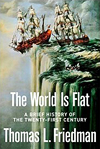Pulitzer prize-winning New York Times columnist, Thomas Friedman, has provided a framework for us to observe the seismic changes that have happened at the dawn of the twenty-first century and have flattened our world. He explains how this flatten-world impacts countries, companies, communities and individuals and how governments and societies can and must adapt. Published in 2005, Friedman defines a flattened world and its potential: “Clearly, it is now possible for more people than ever to collaborate and compete in real time with more other people on more different kinds of work from more different corners of the planet and on more equal footing than at any previous time in the history of the world-using computers, e-mail, networks, teleconferencing, and dynamic new software. . . Connecting all the knowledge centers on the planet together into a single global network, which-if politics and terrorism do not get in the way- could usher in an amazing era of prosperity and innovation.”
Friedman defines three great eras of globalization. Globalization 1.0 lasted from 1492 until around 1800 and centered on countries and muscles. The key agent of change, the dynamic force driving the process of global integration was how much brawn your country had and how creatively you could deploy it. In this era, countries and governments (often inspired by religion or imperialism or a combination of both) led the way in breaking down walls and knitting the world together, driving global integration. In Globalization 1.0, the primary questions were: Where does my country fit into global competition and opportunities? How can I go global and collaborate with others through my country?
Globalization 2.0 lasted roughly from 1800 to 2000, interrupted by the Great Depression and World Wars I and II. The key agent of change, the dynamic force driving global integration, was multinational companies. These multinational companies went global for markets and labor, spearheaded first by the expansion of the Dutch and English joint-stock companies and the Industrial Revolution. In the first half of this era, global integration was powered by falling transportation costs and in the second half by falling telecommunication costs. The big questions in this era were: Where does my company fit into the global economy? How does it take advantage of the opportunities? How can I go global and collaborate with others through my company?
Around the year 2000 we entered Globalization 3.0 where the dynamic force is the newfound power for individuals to collaborate and compete globally. The lever that is enabling individuals and groups to go global so easily and so seamlessly is not horsepower, and not hardware, but software- all sorts of new applications- in conjunction with the creation of a global fiber-optic network that has made us all next-door neighbors. Individuals must, and can, now ask - Where do I fit into the global competition and opportunities of the day, and how can I, on my own, collaborate with others globally? Globalization 3.0 will be driven by a much more diverse- non-Western, non-white-group of individuals. Individuals from every corner of the flat world are being empowered.
There are signs of flattening around you, the call centers in India are just one example. The Indian company MphasiS, has a team of Indian accountants able to do outsourced accounting work from any state in America and the federal government. The founder of MphasiS, Jaithirth Rao, notes “We have tied up with several small and medium-sized CPA firms in America.” “We have taken the grunt work…” Friedman also discovered that in many small and some medium-sized hospitals in the US, radiologists are outsourcing readings of CAT scans to doctors in India and Australia. One advantage is it is day-time in Australia or India when it is nighttime here- after-hours coverage becomes more readily done by shipping the images across the globe.
The world has been flattened by the convergence of ten major political events, innovations and companies. These forces created multiple new forms and tools for collaboration.
Flattener #1 11/9/89
The fall of the Berlin Wall on 11/9/89 unleashed forces that ultimately liberated all the captive peoples of the Soviet Empire and ultimately stimulated outbreaks of freedom across societies in places like India, China and Brazil. It tipped the balance of power across the world toward those advocating, democratic, consensual, free-market-oriented governance, and away from those advocating authoritarian rule with planned economics. Communism was a great system for making people equally poor; capitalism makes people unequally rich. In 1991, India was running out of hard currency and the finance minister at the time, Manmohan Singh, decided to open India’s economy and abolish trade controls. Three years later, after the reforms, the country was growing annually at 7% versus its previous growth rate of 3%. Now to make it you could stay in India, you don’t have to go to the United States. The Berlin Wall was not only a symbol of keeping people inside East Germany-it was a way of preventing a kind of global view of our future. Now we have the ability to think about the world not as East versus West; but as a single market, a single ecosystem, and a single community. The fall of the wall opened the way for more people to tap into one another’s knowledge pools and paved the way for the adoption of common standards-standards on how economies should be run, on how accounting should be done, on how banking should be conducted, on how PCs should be made and on how economic papers should be written. Common standards create a flatter, more level playing field.
“The diffusion of personal computers, fax machines, Windows, and dial-up modems connected to a global telephone network all came together in the late 80’s and early 1990s to create the basic platform that started the global information revolution.” argued Craig Mundie, the chief technology officer for Microsoft. The key was the melding of them all together into a single interoperable system leading to personal empowerment. The walls had fallen and the Windows had opened, making the world much flatter than it had ever been-but the age of seamless global communication had not yet dawned.
Flattener #2 8/9/95
And the next phase, notes Microsoft’s Mundie, “was to go from a PC-based computing platform to an Internet-based platform.” The killer applications that drove this new phase were e-mail and Internet browsing. Netscape went public on August 9, 1995 and the world hasn’t been the same since. Netscape gave us the first broadly popular commercial browser to surf the Internet. The Netscape browser not only brought the Internet alive but also made the Internet accessible to everyone. Windows 95 equipped with a built-in Internet support was rolled out the week after Netscape went public. This development, in turn, wired the whole world together, and made Bagalore India a suburb of Boston.
During the Internet stock boom, there was a huge overinvestment in fiber-optic cable companies, like Global Crossing, which then laid massive amounts of fiber-optic cable on land and under the oceans, which dramatically drove down the cost of making a phone call, or transmitting data anywhere in the world. Unlike other forms of Internet overinvestment, the fiber optics were permanent.
Flattener #3 Work Flow Software
In the late 90s, the software industry began to forge more common Web-based standards, more integrated digital plumbing and protocols, so that anyone could fit his hose-his software applications-onto anyone else’s hydrant. Once this technical foundation was in place, more and more people started writing work flow software programs for more and more different tasks. Shared standards are a huge flattener, because they both force and empower more people to communicate and innovate over much wider platforms. In the span of two or three years, we were able to create virtual global offices-not limited by either the boundaries of your office or your country-and to access talent sitting in different parts of the world and have them complete tasks that you need completed in real time.
The first three flatteners created the platform; the next six flatteners represent the new forms of collaboration which this new platform empowered.
Flattener #4 Open-Sourcing
The open-source movement involves thousands of people around the world coming together online to collaborate in writing everything from their own software to their own operating systems to their own dictionary all available for free. The word “open-source” comes from the notion that companies or ad hoc groups would make available online the source code and then let anyone who has something to contribute improve it and let millions of others just download it for their own use for free. The open source movement became a powerful force when IBM used Apache’s open source code to build their programs. Apache’s Web server was not just useful and valuable but “best in its class.”
Flattener #5 Outsourcing
The fiber optic cables were in place connecting the rest of the world to the US. Y2K required a great deal of computer remediation work requiring the talent of many software engineers. The Y2K work was not going to give the computer companies a competitive advantage; it was just drudge work that needed to be done for as little as possible. India produces well-educated engineers and mathematician in quantity who speak English and they were willing and eager to tackle the tedious work. The Indian IT industry got its footprint across the globe because of Y2K. By early 2000, the Y2K work started to wind down, but then a whole new driver of business emerged-e-commerce. The dot com bubble had not yet burst, engineering talent was scarce, and demand for dot-coms was enormous. So the dot-coms turned to the Indian companies, and they found that they were getting delivery of complex systems, with great quality, sometimes better than what they were getting from others. That created an enormous respect for Indian IT providers.
Outsourcing from America to India, as a new form of collaboration, exploded. Then the dot-com bubble bursts, the stock market tanks, and the pool of investment capital dries ups. American IT companies that survived the boom and venture capital firms that still wanted to fund start-ups had much less cash to spend. Now they needed those Indian engineers not just because there were a lot of them, but precisely because they were low-cost. So the relationship between India and the American business community intensified another notch.
Flattener #6 Offshoring
On December 11, 2001, China formally joined the World Trade Organization, which meant Beijing agreed to follow the same global rules governing imports, exports, and foreign investments that most countries in the world were following. It meant China was agreeing, in principle, to make its own competitive playing field as level as the rest of the world. This gave a huge boost to another form of collaboration-offshoring. Offshoring, which has been around for decades, is different from outsourcing. Outsourcing means taking some specific, but limited, function that your company was doing in-house-such as research, call centers, or accounts receivable- and having another company perform that exact same function for you and then reintegrating their work back into your overall operation. Offshoring, by contrast, is when a company takes one of its factories that is operating in Canton, Ohio, and moves the whole factory offshore to Canton, China. There it produces the very same product in the very same way, only with cheaper labor, lower taxes, subsidized energy, and lower health-care costs. Just as Y2K took India and the world to a whole new level of outsourcing, China’s joining the WTO took Beijing and the world to a whole new level of offshoring-with more companies shifting production offshore and then integrating it into their global supply chains. As other lesser developed countries saw what is going on in China, the have started to offer the same incentives. This has created a process of competitive flattening among countries like Malaysia, Thailand, Ireland, Mexico, Brazil and Vietnam. China’s desire is not simply to be the low cost producer but their goals are also to be a high-quality, hyper-efficient collaborator with worldwide manufacturers on everything.
Flattener #7 Supply-Chaining
Supply-chaining is a method of collaborating horizontally-among suppliers, retailers, and customers-to create value. Supply-chaining is both enabled by the flattening of the world and a hugely important flattener itself, because the more these supply chains grow and proliferate, the more they force the adoption of common standards between companies (so that every link of every supply chain can interface with the next), the more they eliminate points of friction at borders, the more the efficiencies of one company get adopted by the others, and the more they encourage global collaboration. As consumers, we love supply chains, because they deliver us all sorts of goods at lower and lower prices. This is how Wal-Mart became the world’s biggest retailer.
Flattener #8 Insourcing
Companies like FedEx and UPS are not just delivery packages; they are doing logistics inside of companies by synchronizing global supply chains for companies large and small. Very few companies can afford to develop and support a complex global supply chain of the scale and scope that Wal-Mart has developed. That is what gave birth to insourcing. Insourcing came about because once the world went flat, the small could act big. Small companies could sell their goods, manufacture their goods, or buy their raw materials in a more efficient manner. But many of their either didn’t know how to pull all this off or couldn’t afford to manage a complex global supply chain on their own. Many big companies didn’t want to mange this complexity, which they felt was not part of their core competency. This created a whole new global business opportunity for traditional package delivery firms like UPS. In 1996, UPS went into the business of “synchronized commerce solutions.” Friedman calls it insourcing because UPS engineers comes right into your company; analyze its manufacturing, packaging, and delivery processes and then design, redesign, and manage your whole global supply chain. And if necessary, they’ll even finance parts of it, such as receivables, and COD payments.
Flattener #9 In-forming
Companies like Google, Yahoo! Amazon.com and TiVo have learned to thrive not by pushing products and services on their customers as much as by building collaborative systems that enable customers to pull on their own, and then responding with lightening speed to what they pull. In-forming also involves searching for fiends, allies and collaborators. It is empowering the formation of global communities, across all international and cultural boundaries, which is another critically important flattening function.
Flattener #10 The Steroids
“Can You Hear Me Now!” America is catching up with much of the rest of the world in wireless technology. As we progress with wireless technology we are also making great advances in digital, mobile, personal and virtual technology so that our desk goes everywhere with us now. The “mobile me” revolution will be complete when you can move seamlessly around the town, the country, or the world with whatever device you want. The technology is getting there. When this is fully diffused, the “mobile me” will have its full flattening effect, by freeing people to truly be able to work and communicate from anywhere to anywhere with anything.
Friedman dedicates significant portions of the book to fascinating interviews and intriguing insights and stories. At one point in the book, he sums it up with a story he tells his daughters. “Girls, when I was growing up, my parents use to say to me, “Tom, finish your dinner-people in China and India are starving.’ My advice to you is: Girls, finish your homework-people in China and India are starving for your jobs.”



